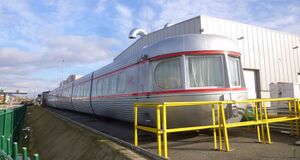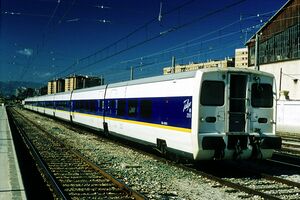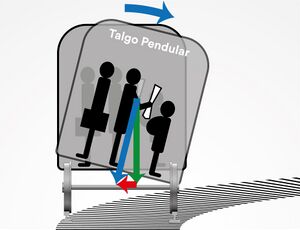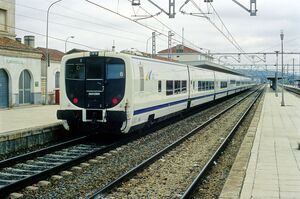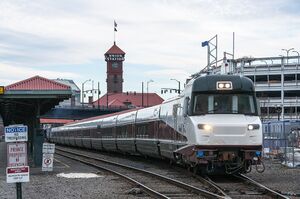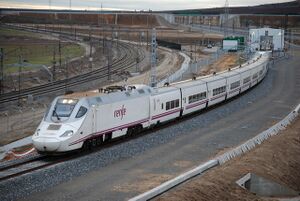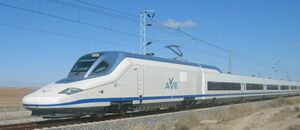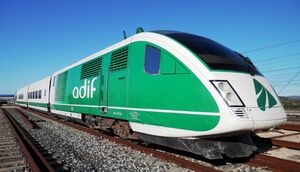تالگو
 | |
| النوع | Sociedad Anónima |
|---|---|
| رمز التداول | BMAD: TLGO |
| ISIN | ES0105065009 |
| الصناعة | Rail vehicle manufacturing |
| تأسست | 1942 |
| المقر الرئيسي | Las Rozas de Madrid, Spain[1] |
| المنتجات | Locomotives High-speed trains Intercity and commuter trains |
| الموظفون | 1,100 (Spain), 2711 (Company, 2021) |
| الموقع الإلكتروني | talgo.com |
Talgo (officially Patentes Talgo, SAU) is a Spanish manufacturer of intercity, standard, and high-speed passenger trains. Talgo is an abbreviation of Tren Articulado Ligero Goicoechea Oriol (English: Lightweight articulated train Goicoechea Oriol).
The company was founded by Alejandro Goicoechea and José Luis Oriol. It was first incorporated in 1942.
Corporate history
The creation of Talgo can be largely credited to the work of Alejandro Goicoechea and José Luis Oriol.[2] During the 1930s, Goicoechea, a pioneering railway engineer, sought to produce a new generation of rolling stock that would be primarily composed of metal, rather than wood; to reduce operational cost, he also emphasised lightweight yet sturdy construction, while a low center of gravity would deter derailing and thus permit higher operating speeds. In 1942, financial backing for the construction of a prototype train was provided by Oriol, which believed in Goicoechea's concepts. The two produced the agreement that established Patentes Talgo as a company that same year. The prototype train would emerge as the Talgo I.[2]
During the late 1940s, Talgo came to recognise that Spain, and the wider European continent, were in a poor economic condition following the Second World War and so were unlikely to be customers for new rolling stock from an unproven manufacturer. Furthermore, the company was keen to acquire advanced technical knowledge and designs, so a favourable agreement was struck with American Car and Foundry (ACF) to collaborate on the manufacture of the Talgo II in the United States.[2] The first vehicles arrived in Spain in 1950, enabling the first commercial Talgo II service to be run on 14 July of that year, between Madrid, Spain and Hendaye, France. It was the first train in Spain to be authorized to travel at a service speed of up to 75 miles per hour (120 km/h). Continued collaboration with ACF led to the creation of the Talgo III during the 1960s. It was brought into service between Madrid and Barcelona in August 1964.[2]
International rail travel between Spain and the rest of Europe had been historically hampered by the differing track gauge at either side of the Pyrenees.[2] Recognising the value in effectively overcoming that impediment, Talgo developed its own variable-gauge vehicle system, which permitted the first international Talgo to be introduced on passenger service between Barcelona, Spain and Geneva, Switzerland, in 1969. Variable-gauge trains were soon a common feature of overnight services between various Spanish cities and destinations across Western Europe.[2] Even into the 21st century, the variable-gauge system has largely remained unchanged, even on newly-built rolling stock.[2] La Gineta is the site of a test track of the Talgo RD railway gauge changer.
During the 1970s, Talgo sought to better accommodate the demand for higher speed trains in Spain. As a consequence of its mountainous terrain, curved tracks prevailed, despite restricting line speeds due to the centrifugal forces exerted on the trains and their contents.[2] To permit higher operating speeds under such conditions, the company developed a tilting train, the Talgo Pendular, that automatically compensated for centrifugal forces by tilting appropriately on bends. Without needing to modify the track infrastructure, this tilting train allowed operating speeds to be increased by up to 25 percent over conventional trains.[2]
During the 1970s and 1980s, the company focused its activities largely on the manufacturing of coaching stock rather than locomotives. A renewed focus on locomotive development, incorporating the automatic variable gauge system, came about during the 1990s. The Talgo XXI pioneered various technologies for the company, including new high-speed running gear and hybrid propulsion technology.[2] In 1988, the Spanish government announced its decision to construct a new dedicated high-speed line between Madrid and Seville. Talgo was keen to produce rolling stock for the new venture and immediately set about designing a new series of trains, the Talgo 350.[2] A key feature of this trainset would be its maximum speed, which was 300 km/h (190 mph). In 1998, Talgo partnered with the multinational rolling stock manufacturer Adtranz to collaborate on its bid to secure a contract to provide the rolling stock for the new high-speed line.[2]
The company's long-term primary customer, and thus the main source of its revenues, is the Spanish railway operator Renfe.[3] By 2001, Talgo was reportedly spending between 10 and 12 percent of its revenues on various research and development programmes.[4]
On 12 May 1999, Talgo announced it had signed a deal to acquire the Finnish rolling stock manufacturer Transtech Oy, which it subsequently reorganised as the wholly-owned subsidiary Talgo Oy.[5] In March 2007, Talgo sold its shares in Talgo Oy to a combination of its local management and other Finnish investors, after which the Transtech name was readopted.[6]
During the 2010s, it was decided that Talgo would be reorganised as a public company.[7] In May 2015, the company made an initial public offering (IPO) on the Bolsa de Madrid, during which it was valued at €1.27 billion.[8]
In recent decades, Talgo has made a renewed effort to expand its presence internationally. During the late 2010s, Talgo made arrangements to establish a new train manufacturing site in the United Kingdom in response to orders for its trains having been placed by multiple British railway operators.[9][10] In the early 2020s, the company invested in new manufacturing facilities in India with the aiming of securing sizable orders from across the country's railways.[11]
Design
Talgo trains are best known for their unconventional articulated railway passenger cars that use in-between carriage bogies that Talgo patented in 1941, similar to the earlier Jacobs bogie. The wheels are mounted in pairs but not joined by an axle and the bogies are shared between coaches rather than underneath individual coaches. This allows a railway car to take a turn at higher speeds with less hunting oscillation. As the coaches are not mounted directly onto wheel bogies, the coaches are more easily insulated from track noise. This design has been proposed for further utilisation in the Talgo 22, double deck train with stepless access from the platform to the lower deck and between carriages.[12]
Talgo trains fitted with variable gauge axles can change rail gauge - for instance at the 1٬668 mm Iberian gauge/1٬435 mm standard gauge at the Spanish-French border interchange.[13]
Since the introduction of the Talgo Pendular in 1980, the train tilts naturally inwards on curves, allowing it to run faster on curves without causing discomfort to passengers. The carriage tilting system pivots around the top of the suspension columns, which has the effect of partially cancelling the effects of lateral acceleration when cornering.
Trains
Talgo trains are divided into generations. They come in both locomotive hauled and self-propelled versions.
Talgo I
The Talgo I was built in 1942 in Spain. The coaches were built at the "Hijos de Juan Garay" workshop in Oñati and the power car was built at the workshops of the "Compañía del Norte" in Valladolid.[14] It was built as a prototype, and it was used to set several rail speed records.[4] The first test run occurred between Madrid and Guadalajara, Castile-La Mancha in October 1942.[15] It had a max speed of 115 km/h (71 mph) on uphills and 135 km/h (84 mph) on flat/downhills.[16] The trainset was destroyed on February 5, 1944 after approximately 3000 km of testing in a fire at its storage location, a warehouse in Cerra Negro.
Talgo II
Talgo II coaches and locomotives were first built in 1950 at the American Car and Foundry Company (ACF) works in the United States under the direction of Spanish engineers (the diesel-electric locomotives were assembled by ACF with electrical components made by General Electric). Talgo II carried most of the Jet Rocket train's passengers between Chicago and Peoria, Illinois, after entering service on the Chicago, Rock Island and Pacific Railroad (the Rock Island line) in 1956. Slightly different coaches were later introduced, and the last car type of the Jet Rocket resembled that of the future Talgo III.[17] The New York Central Railroad trialed a complete train until 1958 but saw little success.[18]
Talgo IIs also entered service under Renfe as the Renfe Class 350, where they ran between Madrid and Palencia.[19]
Talgo IIs were also built for the New York, New Haven and Hartford Railroad for its "John Quincy Adams" train from New York City to Boston, Massachusetts, and the Boston and Maine Railroad for its "Speed Merchant" train, running between Boston and Portland, Maine.[20] Soon afterwards, Talgo II trains began running in Spain and were successfully operated until 1972.[14]
Talgo III
Talgo III coaches and locomotives entered service in 1964, introducing longer cars and easy directional reversibility of the coaches. The Talgo III/RD was equipped with variable gauge axles, and this permitted the introduction, on 1 June 1969, of the first through train between Barcelona and Geneva (the Catalan Talgo), despite the difference in rail gauge.[4][21] The same equipment was used for the Barcelona Talgo, which began operation on 26 May 1974 as the first-ever through train service between Barcelona and Paris.[22]
Talgo Pendular
The Talgo Pendular (Talgo IV and Talgo V, also VI & Talgo 200 or 6th generation), introduced in 1980, created the "natural tilting" train, using a passive system that tilts the carriages with no need for electronic sensors or hydraulic equipment.[3] The wheels are mounted on mono axles between the carriages, and sitting on top of the axles are suspension columns. The carriages are attached to the top of the suspension columns and swing inwards as the train goes through a curve.
In 1988, a Talgo Pendular was used on trials for Amtrak on the Boston-New York corridor in the United States and on Deutsche Bahn lines in Germany.[14] Trial commercial services with Talgo cars in the US commenced in 1994 between Seattle and Portland, and from 1998 different trains have been used on the Amtrak Cascades services from Vancouver, British Columbia to Seattle, Washington, continuing via Portland, Oregon to Eugene, Oregon.[23] Five Talgo IV trains were in use in Argentina on the General Roca Railway. They have since been replaced by CRRC Dalian rolling stock. In September 2022, the Talgo IV sets were transported to the Villa Luro workshop to undergo repairs, aiming to add an extra daily service between Buenos Aires and Rosario.[24] The sets used on the Amtrak Cascades have been replaced by Amtrak-owned Horizon cars.
Talgo 200 series trains are also in use in Kazakhstan for the Almaty–Astana overnight train.[25]
Talgo VII
The Talgo VII introduced beginning in 2000 is used as a locomotive-pulled train set as well as intermediate cars for the multiple units Talgo 250, Talgo 350 and Talgo XXI. The carriages are similar to the Talgo Pendular type but have an air-controlled hydraulic brake system and power supply from head end power instead of diesel engine-generators in the end cars. Talgo VII trains have a car which has two pairs of wheels in the middle of the set (of cars) rather than at one end of the set, which is the case for earlier Talgo trains. All the other cars in the set have a single pair of wheels.[26]
Talgo 8
The Series 8 passenger cars are similar to the Series VII cars, but the diesel generator car at one end of the train has a control cabin for push-pull operation and a two-axle end bogie. These trains are designed for the North American market. Talgo made an agreement in 2009 to build a manufacturing facility in Wisconsin which would initially supply two 14-car trainsets for the Amtrak Hiawatha Service until the project was cancelled. The company expressed hope the plant would later be used to build trains for other U.S. rail projects.[27][28]
Early in 2010, the Oregon Department of Transportation announced that it had negotiated the purchase of two 13-car trainsets for use in the Pacific Northwest rail corridor between Eugene and Vancouver, British Columbia.[29] These trainsets were also manufactured in Wisconsin and were delivered in 2013. The sets are currently operating in the "Cascades" corridor in the Pacific Northwest. They have been integrated with the five existing sets in regular service.[30] The Series 8 trains offer passengers many modern amenities including high-speed Wi-Fi, reclining seats and a full-service bistro and lounge car.
In 2014, the state of Michigan expressed interest in operating the unused Talgo 8 cars for their Amtrak Wolverine service.[31] Three years later, Amtrak proposed to lease or buy the unused cars in the wake of the 2017 Washington train derailment. Ultimately, the two trainsets were sold to Nigeria for use on the Lagos Rail Mass Transit.[32]
Talgo 9
This series, which was originally designed for Russia and Kazakhstan, featured wide bodyshells and wheelsets. There are three versions, consisting of either 1520 mm fixed gauge, 1520-1435 mm variable gauge or 1520-1676 mm variable gauge. They are used in the Berlin-Moscow line (December 2016), St. Petersburg-Moscow-Samara (August 2020).
In July 2015, Talgo stated its intention to ship a Series 9 train to India at its own cost as a demonstration on the Mumbai-Delhi rail route.[33][34] On 10 September 2016, the final successful test run of the Talgo 9 series coaches was completed in India.[35]
Talgo 250 HSR
The Talgo 250 is a dual voltage electric train (AC/DC) equipped with variable gauge axles. This allows the units to be used on high-speed lines and on conventional broad gauge lines. A Talgo 250 train consists of two power cars and 11 Talgo VII intermediate coaches. This class was developed for Renfe (classed as S-130).[36] One trainset (RENFE Class 730) was involved in the Santiago de Compostela accident on 24 July 2013.
Uzbekistan Railways ordered two Talgo 250 sets of a Russian gauge version in 2009. The first set arrived at Tashkent in July 2011.[37]
Talgo 250 Hybrid
The Talgo 250 Hybrid is a dual-voltage, dual-power train equipped with variable gauge axles. The train is therefore also able to operate on non-electrified lines. A Talgo 250 Hybrid train consists of two power cars, two technical end coaches and nine Talgo VII intermediate coaches. The trains were developed for Renfe and classed initially as S-130H, later as S-730. They are rebuilt from existing Talgo 250 trains.[38]
Talgo 350 HSR
The Talgo 350 entered service as the Renfe AVE Class 102 marking the company's entry into the high-speed train manufacturing market. Tests with the prototype commenced in 1994,[14] and Talgo 350 trains have been operating at a top commercial speed of 330 km/h on the Madrid-Barcelona and Madrid-Valladolid lines since 22 December 2007. This series of trains is designed to reach a speed of 350 km/h (220 mph), although present lines and commercial services limit the speed to 330 km/h (205 mph).[39][40] The train consists of two power cars and Talgo VII intermediate cars with improved brakes and additional primary suspension.[26]
Talgo XXI HSR
Talgo XXI is a project for a high-speed diesel-powered train, that operates in push-pull with one or two power cars and Talgo VII intermediate cars. The North American version has four-axle power cars in compliance with United States FRA regulations. Only one train in compliance with European UIC standards has been built to date.[41] Talgo reported that the Talgo XXI attained 256 km/h (159 mph) on the Olmedo-Medina del Campo high speed experimental line on 9 July 2002,[42] which led to a claim for the world speed record for a diesel train. However, this claim was never proven.[محل شك] After the test runs the train was sold to the Spanish infrastructure authority ADIF as a measuring train for high-speed lines.
Possible specs are:
- Two MTU 12V 4000 R64 engines (two power car configuration) or one MTU 12V 4000 R84 engine (one power car configuration), up to 1,800 rpm, high-speed diesel, Euro IIIB compliant with diesel particulate filter and exhaust gas recirculation after-treatment system
- 2 x 1,500 kW (2,000 hp), (3 MW [4,000 hp]) or 1,800 kW (2,400 hp)
- Voith hydraulic transmission
- Hydrodynamic and air braking
- Variable gauge
- 5 to 12 passenger coaches, depending on the setup
- Up to 400 seats
- Designed for a top speed of 220 km/h (135 mph)
- Power car with a shared trailer axle
Talgo AVRIL HSR
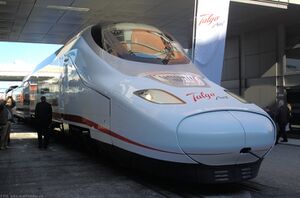
Talgo has developed recently a train known as "AVRIL" (Alta Velocidad Rueda Independiente Ligero — Light High-Speed Independent Wheel), intended for speeds of 380 kilometres per hour (240 mph).[43] The system uses underfloor traction in the front and rear vehicles, with the intermediate carriages having the Talgo Pendular system (which cannot use motored axles on the axles corresponding to the system). The train also has the option for variable gauge axles. Starting with the concept stage in 2009, it began dynamic testing on the Spanish high-speed network in 2014,[44] and was approved in May 2016. It won its first major contract in November 2016 from Renfe for the Mediterranean corridor in Spain, and its link to Paris.[45]They are set to start commercial operations in March 2024.[46]
تالجو مصر
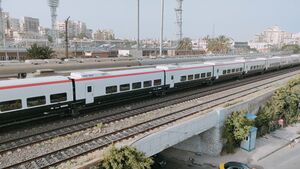
In April 2019, Egypt ordered new Talgo trains.[47] Egypt contracted for six trains from Talgo Company, but they became seven trains due to a delay in the delivery date to Egypt. This negates the words of the Minister of Transport who justified that train is a gift from the company for President Abdel Fattah El-Sisi.[48]
There is also a possibility of corruption in the train deal, as Transport Minister Kamel Al-Wazir announced that the deal cost Egypt $126 million, but the company announced the details of the deal, which amounted to $172 million, on their website.[49]
On 9 August 2022, Egypt contracted for seven trains from Talgo, which included 15-year maintenance, for 280 million euros. The trains will be delivered at the beginning of 2024.[50][51]
Variable Gauge Axles (VGA)
In addition to the multiple units with variable gauge, Talgo built in 2005 a prototype of a variable gauge locomotive (the L-9202, TRAV-CA, 130-901 or Virgen del Buen Camino).[52][53]
See also
References
- ^ "Information about Talgo" (PDF). railgrup.net. Archived from the original (PDF) on 25 April 2012 – via Internet Archive.
- ^ أ ب ت ث ج ح خ د ذ ر ز س "Talgo: A Train Ahead of the Curve". Spanish Railway Foundation. Retrieved 23 January 2023.
- ^ أ ب Guillen, Mauro F. (2005). The Rise of Spanish Multinationals. Cambridge University Press. ISBN 9780521847216. Retrieved 7 May 2008 – via Google Books.
- ^ أ ب ت Guillen, Mauro F. (2001). The Limits of Convergence. Princeton, New Jersey: Princeton University Press. p. 104. ISBN 0-691-05705-2. Retrieved 4 May 2020 – via Internet Archive.
Talgo III RD.
- ^ "Talgo to buy Transtech". Railway Gazette. 1 June 1999.
- ^ Barrow, Keith (4 August 2015). "Škoda acquires controlling stake in Transtech". International Railway Journal.
- ^ "Industry News in Brief". Railway Gazette. 5 November 2011.
- ^ "IPO values Talgo at €1.27bn". Railway Gazette. 7 May 2015. Retrieved 15 July 2015.
- ^ Longhorn, Danny (21 February 2020). "Talgo on tour: 'true manufacturing' plan has tremendous support". railbusinessdaily.com.
- ^ Clinnick, Richard (9 October 2018). "Talgo shortlists English and Welsh locations for new factory". railmagazine.com.
- ^ Madhukalya, Anwesha (10 July 2020). "Early bird will rake-in in private trains, says Talgo; plans India manufacturing". businesstoday.in.
- ^ "Talgo 22". yumpu.com.
- ^ "Variable gauge system Talgo RD 2008" – via www.youtube.com.
- ^ أ ب ت ث "Historia de Talgo". www.talgo.com. Archived from the original on 22 May 2010. Retrieved 15 June 2010.
- ^ "Historie". www.talgo.de. Archived from the original on 6 February 2012. Retrieved 3 October 2014.
- ^ "Talgo America - Historic Milestones". web.talgoamerica.com. Retrieved 2023-02-09.
- ^ (1) "The Jet Rocket". Streamliner Memories. 1 March 2013. Retrieved 12 May 2020. "The Jet Rocket |". Archived from the original on 13 May 2020. Retrieved 13 May 2020 – via Internet Archive.
{{cite web}}: CS1 maint: bot: original URL status unknown (link)
(2) "EMD LWT12 locomotive No. 1 (serial number 20826) pulling the Jet Rocket train on the Chicago, Rock Island and Pacific Railroad" (photograph). c. 1956. Retrieved 4 May 2020 – via Flickr. - ^ Guillen, Mauro F. (2001). The Limits of Convergence. Princeton, New Jersey: Princeton University Press. p. 104. ISBN 0-691-05705-2. Retrieved 4 May 2020 – via Internet Archive.
In 1948 the American Car and Foundry Company of Hoboken, New Jersey, and Wilmington, Delaware, agreed to manufacture three Talgo II trains. Two of them were shipped back to Spain to enter scheduled commercial service in 1950. The third was tested and used for passenger traffic on the New York Central Railroad until 1958 with little commercial success
- ^ "Picture Gallery - Directory: /pix/es/diesel/historic/350". www.railfaneurope.net. Retrieved 2023-02-08.
- ^ Kirkland, John F. (November 1985). The Diesel Builders Volume 1: Fairbanks-Morse and Lima-Hamilton. Interurban Press. ISBN 0-916374-69-6.
- ^ "Stop Press" (changes taking effect). Cooks Continental Timetable (June 1969 edition), p. 6; also pp. 71, 106. London: Thomas Cook Publishing.
- ^ "Barcelona Talgo". Thomas Cook Continental Timetable (June 1975 edition), p. 466. Thomas Cook Publishing.
- ^ "TALGO AMERICA - History". www.talgoamerica.com. Archived from the original on 25 June 2008. Retrieved 7 May 2008 – via Internet Archive.
- ^ "Trasladan formaciones Talgo a los talleres de Villa Luro para su reparación". enelSubte. 21 September 2022.
- ^ "Kazakhstan Buys Two Talgo Trains". International Railway Journal. 1 December 2000. Archived from the original on 24 September 2015 – via Internet Archive.
- ^ أ ب Christian Torrego (Translation by P.L. Guillemin (April 2003). "Talgo 7". talgo.ifrance.com. Archived from the original on 3 April 2009. Retrieved 29 December 2008.
- ^ "Wisconsin wants Talgo trains". Railway Gazette International. 21 July 2009. Retrieved 15 December 2009.
- ^ "History: North American Milestones". Talgo America. Archived from the original on 26 December 2010. Retrieved 15 December 2009.
- ^ "ODOT purchases passenger trains". oregon.gov. Retrieved 28 February 2010.
- ^ "Oregon's new trains, new schedule begin Jan. 6". oregon.gov. Retrieved 22 March 2015.
- ^ "Amtrak's Detroit-Chicago trip to get faster, plusher with upgrades". The Detroit News. 15 September 2014. Archived from the original on 6 October 2014. Retrieved 22 October 2014 – via Internet Archive.
- ^ "Never-used Talgo trainsets find a buyer in Africa". trains.com. 20 January 2022.
- ^ Dhoot, Vikas (24 July 2015). "Train from Spain: Government considering Talgo proposal to run trial runs of faster trains trains between Mumbai, Delhi". Economic Times. New Delhi, India. Retrieved 24 July 2015.
- ^ For trial run in India, wheelset being adjusted from 1520mm (Russian gauge) to 1676mm (Indian gauge).
- ^ "Superfast Talgo train to run from Delhi to Mumbai in 12 hours in final test run". The Economic Times.
- ^ "Productos Talgo". www.talgo.com. Archived from the original on 18 April 2008. Retrieved 7 May 2008 – via Internet Archive.
- ^ "Uzbekistan Temir Yollari Talgo 250 - Ferropedia". ferropedia.es. Retrieved 6 April 2018.
- ^ "Talgo 250" (PDF). www.talgo.com. Archived from the original (PDF) on 15 September 2011. Retrieved 28 August 2011 – via Internet Archive.
- ^ "Spain's Great Rail Race - High-Speed Train Lines". www.railway-technology.com. 29 July 2007. Retrieved 7 May 2008.
- ^ "Talgo evolves its unique design for ultra-high speed. (High Speed: Spain)". International Railway Journal. 1 October 2002. Archived from the original on 9 April 2016.
- ^ "TALGO AMERICA - Talgo XXI". www.talgoamerica.com. Archived from the original on 24 June 2008. Retrieved 7 May 2008 – via Internet Archive.
- ^ "Talgo: History". www.talgo.com. Archived from the original on 18 April 2008. Retrieved 2 June 2008 – via Internet Archive.
- ^ "Talgo's 380 km/h Avril train to take on the airlines". Railway Gazette International. 27 July 2009. Archived from the original on 24 November 2020. Retrieved 28 October 2010.
- ^ Puente, Fernando (9 September 2014). "Talgo Avril starts dynamic testing". railjournal.com. Retrieved 6 April 2018.
- ^ "Talgo wins the most important high-speed tender in Europe". Talgo. Retrieved 19 August 2017.
- ^ Vila, Carlos I. Castrillón, Ángel (2024-01-05). "Los trenes Avril a 300 km/h Vigo-Madrid llegan con los Reyes Magos, y serán también low cost". Metropolitano (in الإسبانية). Retrieved 2024-01-07.
{{cite web}}: CS1 maint: multiple names: authors list (link) - ^ "First Talgo train for Egypt due to arrive in November". Railpage.
- ^ "Talgo increases its net profit by 52.8% and obtains €40.1 million in FY2019".
- ^ "ENR: adapted to the environment".
- ^ "Talgo gains new contract in Egypt for €280 million". talgo.com.
- ^ "Talgo starts operating its Intercity trains in Egypt". talgo.com.
- ^ "TRAVCA article in Ferropedia.es". ferropedia.org. Retrieved 6 April 2018.
- ^ "THE EST CRASH BUFFER - Information and References on the EST Crash Buffers G1, R1 and X1". www.crashbuffer.com. Retrieved 6 April 2018.
External links
- Talgo Official Site
- Talgo America Web site (English)
- Talgo Deutschland
- Interactive 360° panoramas of the interiors of Talgo 7, Avril, Talgo 4 cama, Talgo 6 (DB)
قالب:Renfe locomotives قالب:Amtrak rolling stock خطأ لوا في وحدة:Authority_control على السطر 278: attempt to call field '_showMessage' (a nil value).


